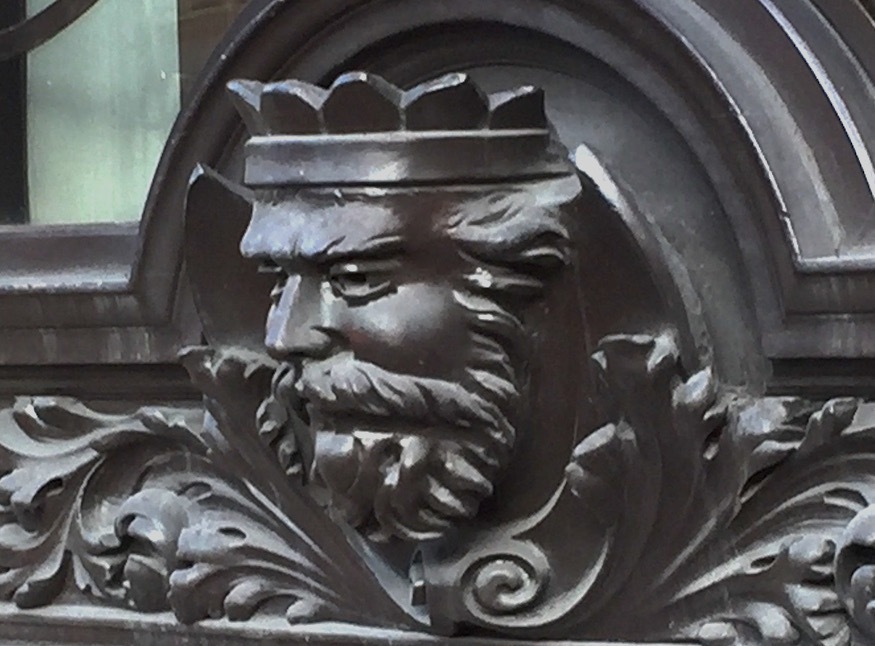For more of all things London history, sign up for our new (free) newsletter and community: Londonist: Time Machine

Track down the four hidden faces of King Lud — mythical founder of our city.
Ever heard of King Lud? You won't find him in any modern royal chronology. Yet he supposedly gave his name to Ludgate Hill, Ludgate Circus and even London itself.
Lud's legend comes mostly from the quill of Geoffrey of Monmouth, the 12th century chronicler who spliced oral tradition and verifiable fact into sparkling if unreliable histories. Lud, we learn, was a pre-Roman ruler of Britain, who rebuilt the city of London. He named his city Caer Lud — Lud's fortress — which would later evolve into London. Not a shred of primary evidence exists to support any of this — no evidence of any significant town before the Romans has ever been found — but it's all good fun.
The mythical king is hidden in our history, but he is also hidden among our buildings. You'll find his features at either end of Fleet Street, though only if you're the sort of person who goes peeking into corners and peering up at rooftops.
Three of London's oldest statues

Here's the man himself, flanked by his two sons Androgeus and Theomantius. This weather-worn trio are contenders for London's oldest statues (here's another). As you can see from the ad hoc sign, they may date from the 14th century — although hard evidence seems lacking. A print from 1795 gives us a feel for how they might have looked in their prime.
The statues previously adorned the gateway known as Ludgate, until it was dismantled in the 18th century. They eventually found a new home within a niche at St Dunstan-in-the-West. And there they remain today.

They're not easy to spot. You have to walk into the churchyard and approach the statue of Elizabeth I (who was also reclaimed from Ludgate). Head under her archway, and you'll find the royal party waiting for you on the left.
Incidentally, the church makes other nods to London's pagan myths. The Fleet Street frontage is famous for its prominent clock which features the giants Gog and Magog beating the hour bell with their clubs.
The three Luds of Ludgate Circus
We're not quite done with our fictitious founding father. King Lud also appears in triplicate, a short stroll away on Ludgate Circus. Here, you're looking for the long-established Leon restaurant on the north-east corner.

This handsome building was formerly the Old King Lud, a landmark pub that seems to have changed name to the Hogshead in the 90s, before closing for good in 2005. The king has not left the building, however.
Leon has two sets of doors. Above each, you'll notice these spectacular casts of the king's crowned head.

The royal countenance is a powerful one. Admire the rich beard and strong brow; tremble at that wise yet penetrating gaze, which seems wasted on the Dry Cleaning Express across the junction.
According to Monmouth's legends, Lud was buried hereabouts, beside the gate that bears his name. These, then, can be considered funerary monuments to a man who never lived.

There is a third Lud here, and I suspect it goes mostly unnoticed. Look up to the roofline and you'll glimpse one final copy of the fabulous king's face. It's in a similar style to the sculptures below, suggesting all three are original architectural features of this building.
Doesn't it all make you wish that modern developments could weave in a little bit of historical whimsy? I mean, this is what sits on the adjacent corner of Ludgate Circus 👇

I'm sure it's all energy efficient and cleverly engineered for a sustainable future. But how much more exciting is the old-fashioned neighbour with its intricate layers and regal protrusions? Or perhaps I'm just being a luddite*.
Anyhow, next time you're walking along Fleet Street, be sure to pay obeisance to His Apocryphal Majesty. For a man who never existed, King Lud has a lot of presence.
*The fictional king is part of the etymology of the word luddite.




